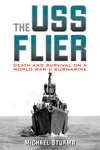Recent additions

Smoke and Mirrors
by Deborah LakeQ-Ships against the U-Boats in the First World War
2009, The History Press
ISBN 0752450557
Paperback, 256 pages
The Q-ship, an ordinary merchant vessel with concealed guns, came into its own during World War I, when used by the Royal Navy to trap and destroy German U-boats. The Q-ship operations are covered here in detail, by following the careers of the eight men who won the Victoria Cross on Special Service Operations; and by accounts of German U-boat crews being on the receiving end. No book on Q-ships can avoid the Baralong incident in which a Q-ship's crew allegedly executed the survivors of the German submarine U-27, on August 19, 1915. In a subsequent encounter with U-41, more British atrocities were alleged by the only two German survivors. Revealing extracts from the diary of a Royal Marine who served on board the Baralong are reproduced here, together with other first-hand accounts. With charge and counter-charge, this incident provides a fascinating story.
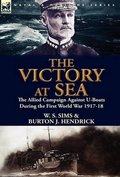
The Victory at Sea
by W. S. Simsthe Allied Campaign Against U-Boats During the First World War 1917-18
2012, LEONAUR
ISBN 1782820426
Hardcover, 340 pages
Victory snatched from imminent defeat This book by the American, Admiral Sims will be a revelation to many. The British public had no idea that by the time America entered the First World War on 6th April, 1917 the Allied cause was on the brink of falling to the might of Imperial Germany. No plan had been conceived to ensure that vital materials would reach Britain by sea without them falling prey to the omnipresent U-Boat menace. Thousands of tons of essential war supplies were going to the bottom of the Atlantic Ocean each week and serious Allied analysts believed that Britain would last less than four months before surrender was inevitable. Given what we now know of the great German land offensives of the final phase of the war, the consequences for the Allies, without a solution to the issue of maritime supply, could have been catastrophic. The solution came in the form of the creation of the convoy system and its effectiveness was due in no small part to the addition of the U. S. N. destroyer fleet to support the activities of the Royal Navy. This book describes how the German U-Boat threat was finally overcome and how this impacted on the Allied victory. Sims also gives much operational detail including the activities of the deadly decoy's, the 'Q' ships, and the operations of the 'King Cobras' of the undersea war-the anti-submarine submarines.' This is the view and account of a senior officer in a position to experience and describe for posterity the strategic and tactical issues of the anti U-Boat campaign and it describes in detail the many methods and types of craft employed together with anecdotes, reports and eyewitness accounts of the action on and under the waves. Recommended. Leonaur editions are newly typeset and are not facsimiles; each title is available in softcover and hardback with dustjacket; our hardbacks are cloth bound and feature gold foil lettering on their spines and fabric head and tail bands.
Purchase information: (help)
 Get The Victory at Sea now at amazon.co.uk (£ 21.00)
Get The Victory at Sea now at amazon.co.uk (£ 21.00)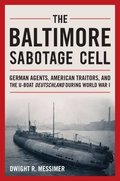
The Baltimore Sabotage Cell
by Dwight R. MessimerGerman Agents, American Traitors, and the U-boat Deutschland During World War I
2015, Naval Institute Press
ISBN 1591141842
Hardcover, 280 pages
By the summer of 1915 Germany was faced with two major problems in fighting World War I: how to break the British blockade and how to stop or seriously disrupt the British supply line across the Atlantic. Th e solution to the former was to find a way over, through, or under it. Aircraft in those days were too primitive, too short range, and too underpowered to accomplish this, and Germany lacked the naval strength to force a passage through the blockade. But if Germany could build a fleet of cargo U-boats that were large enough to carry meaningful loads and had the range to make a round trip between Germany and the United States without refueling, the blockade might be successfully broken.Since the German navy could not cut Britain’s supply line to America, another answer lay in sabotaging munitions factories, depots, and ships, as well as infecting horses and mules at the western end of the supply line. German agents, with American sympathizers, successfully carried out more than fifty attacks involving fires and explosions and spread anthrax and glanders on the East Coast before America’s entry into the war on 6 April 1917.Breaking the blockade with a fleet of cargo U-boats provided the lowest risk of drawing America into the war; at the same time, sabotage was incompatible with Germany’s diplomatic goal of keeping the United States out of the war. The two solutions were very different, but the fact that both campaigns were run by intelligence agencies?the Etappendienst (navy) and the Geheimdienst (army), through the agency of one man, Paul Hilken, in one American city, Baltimore, make them inseparable. Those solutions created the dichotomy that produced the U-boat Deutschland and the Baltimore Sabotage Cell. Here, Messimer provides the first study of the degree to which U.S. citizens were enlisted in Germany’s sabotage operations and debunks many myths that surround the Deutschland.
Purchase information: (help)
 Get The Baltimore Sabotage Cell now at amazon.co.uk (£ 30.50)
Get The Baltimore Sabotage Cell now at amazon.co.uk (£ 30.50)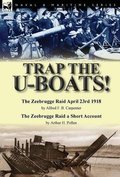
Trap the U-Boats!
by Alfred F. B. CarpenterThe Zeebrugge Raid April 23rd 1918 by Alfred F. B. Carpenter & The Zeebrugge Raid a Short Account by Arthur H. Pollen
2015, LEONAUR
ISBN 1782824677
Hardcover, 244 pages
A desperate raid to save the merchant ships that supplied the Allied cause From the first months of 1915, when the Great War on the Western Front ground to a stalemate of fixed lines of trenches, the protagonists were committed to a conflict of attrition. Neither side could affect a military breakthrough, but the Allies had the distinct advantages of both unrestricted access to the worlds seaways and the a steady stream of materiel which crossed the Atlantic from the United States of America. To disrupt this essential war traffic Germany fine tuned submarine warfare in the form of the U-Boat. This countermeasure proved so effective that the huge number of merchant vessels sunk by German submarines meant that by 1917 there was a realistic potential that the Allies might lose the war having been denied sufficient resources to continue to fight. To hinder the effectiveness of the U-Boat 'wolf-packs,' a daring raid was devised to blockade the principal submarine base at the port Zeebrugge in Belgium by sinking a vessel in the approaches to its harbour. This audacious action, carried out by the Royal Navy, became one of the most remarkable feats of naval warfare of the First World War. This Leonaur book contains two accounts of the Zeebrugge Raid and is recommended. Leonaur editions are newly typeset and are not facsimiles; each title is available in softcover and hardback with dustjacket; our hardbacks are cloth bound and feature gold foil lettering on their spines and fabric head and tail bands.
Purchase information: (help)
 Get Trap the U-Boats! now at amazon.co.uk (£ 19.00)
Get Trap the U-Boats! now at amazon.co.uk (£ 19.00)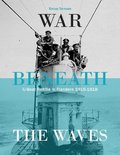
War Beneath the Waves
by Tomas TermoteU-Boat Flotilla Flandern
2017, Uniform Press
ISBN 191050064X
Hardcover, 352 pages
Amid the stalemate of World War I, one area in which the German military could claim almost complete supremacy was beneath the ocean. In the four years of the war, the U-boats of U-Flottille Flanders alone would sink more than 2,500 Allied ships, sending more than 2.5 million tons of shipping to the bottom. But their victories came at a high cost: as the Royal Navy made taking out U-boats a priority, using mines, nets, aircraft, espionage, and more, and by the end of the war they had sunk eighty percent of the U-boats that operated out of Flemish ports. ?This book brings the secret of those sunken subs back to the surface. Underwater archaeologist and naval historian Tomas Termote draws on his countless visits to the wrecks of U-boats to explore topics ranging from their role in the war to the everyday lives of the men on board. Termote illustrates his account with copious underwater photography of the wrecks, and he uses that and new identifications to present the first ever complete account of the fate of every U-boat in the fleet, including boats sunk off the coasts of Great Britain, Belgium, Holland, France, Ireland, Spain, and the United States. The result is a book sure to grip any WWI buff, helping us understand with new clarity one of the crucial theaters of the war.
Purchase information: (help)
 Get War Beneath the Waves now at amazon.com ($ 35.40)
Get War Beneath the Waves now at amazon.com ($ 35.40) Get War Beneath the Waves now at amazon.co.uk (£ 30.00)
Get War Beneath the Waves now at amazon.co.uk (£ 30.00)
The Battles of Coronel and the Falklands, 1914
by Geoffrey Bennett2014, Pen and Sword
ISBN 1783462795
Paperback, 192 pages
The defeat that Rear-Admiral Sir Christopher Cradock suffered at Coronel in 1914 at the hands of Maximilian Graf von Spee, one of Germany’s most brilliant naval commanders, was the most humiliating blow to British naval prestige since the eighteenth century and a defeat that had to be avenged immediately. On 8 December 1914, the German squadron steamed towards Port Stanley, unaware that in the harbor lay two great British battle-cruisers, the ‘Invincible’ and ‘Inflexible’. Realizing this, Spee had no option but to turn and flee. Hour by hour during that long day, the British ships closed in until, eventually, Spee was forced to confront the enemy. With extraordinary courage, and against hopeless odds, the German cruisers fought to the bitter end. At five-thirty that afternoon, the last ship slowly turned and rolled to the bottom. Cradock and Britain had been avenged.
Purchase information: (help)
 Get The Battles of Coronel and the Falklands, 1914 now at amazon.co.uk (£ 12.99)
Get The Battles of Coronel and the Falklands, 1914 now at amazon.co.uk (£ 12.99)
Dead Wake
by Erik LarsonThe Last Crossing of the Lusitania
2015, Crown Publishers
ISBN 0307408868
Hardcover, 430 pages
#1 New York Times BestsellerFrom the bestselling author and master of narrative nonfiction comes the enthralling story of the sinking of the LusitaniaOn May 1, 1915, with WWI entering its tenth month, a luxury ocean liner as richly appointed as an English country house sailed out of New York, bound for Liverpool, carrying a record number of children and infants. The passengers were surprisingly at ease, even though Germany had declared the seas around Britain to be a war zone. For months, German U-boats had brought terror to the North Atlantic. But the Lusitania was one of the era’s great transatlantic “Greyhounds”—the fastest liner then in service—and her captain, William Thomas Turner, placed tremendous faith in the gentlemanly strictures of warfare that for a century had kept civilian ships safe from attack. Germany, however, was determined to change the rules of the game, and Walther Schwieger, the captain of Unterseeboot-20, was happy to oblige. Meanwhile, an ultra-secret British intelligence unit tracked Schwieger’s U-boat, but told no one. As U-20 and the Lusitania made their way toward Liverpool, an array of forces both grand and achingly small—hubris, a chance fog, a closely guarded secret, and more—all converged to produce one of the great disasters of history. It is a story that many of us think we know but don’t, and Erik Larson tells it thrillingly, switching between hunter and hunted while painting a larger portrait of America at the height of the Progressive Era. Full of glamour and suspense, Dead Wake brings to life a cast of evocative characters, from famed Boston bookseller Charles Lauriat to pioneering female architect Theodate Pope to President Woodrow Wilson, a man lost to grief, dreading the widening war but also captivated by the prospect of new love. Gripping and important, Dead Wake captures the sheer drama and emotional power of a disaster whose intimate details and true meaning have long been obscured by history.
Purchase information: (help)
 Get Dead Wake now at amazon.co.uk
Get Dead Wake now at amazon.co.uk Before Jutland
by James GoldrickThe Naval War in Northern European Waters, August 1914-February 1915
2015, Naval Institure Press
ISBN 9781591143499
Paperback, 382 pages, 11 maps
A balanced account of naval operations in the North Sea and the Baltic during the opening months of WWI
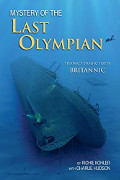
Mystery of the Last Olympian
by Richie KohlerTitanic's Tragic Sister Britannic
2016, Best Publishing Company
ISBN 1930536860
Paperback, 228 pages
The book gives you a firsthand account as Richie Kohler (of Shadow Divers and Deep Sea Detectives) takes readers on the intriguing journey from the rise of the magnificent Olympians to the fateful day in 1916. He then moves forward in time through multiple expeditions beginning with the great Jacques Cousteau who located the ocean liner in 1975. Each successive team that risked their lives uncovered new clues, but it was not until 2009 when Richie and his dive partner definitively pinpointed the secret that had eluded them. Finally, in July 2015, Richie and a small team attained the goal of documenting their findings that answered the century-old question as to why all the engineering solutions built into the mighty Britannic could not save her from sharing the same fate as Titanic. Experience the expedition as Richie and his team unravel the mystery of the HMHS Britannic: With damage to only one compartment, the ship should have been able to stay afloat, and yet she sank twice as quickly as did Titanic. How was that possible? Was the hospital ship criminally torpedoed as the British press claimed, or did she ineptly blunder into a minefield, as the Bismarck Government countered? Violet Jessop survived the sinking of Britannic and Titanic. Experience her intriguing story.
Purchase information: (help)
 Get Mystery of the Last Olympian now at amazon.co.uk (£ 19.99)
Get Mystery of the Last Olympian now at amazon.co.uk (£ 19.99)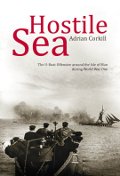
Hostile Sea
by Corkill, AndrianThe U-boat Offensive around the Isle of Man during World War One
2013, Adrian Korkill
ISBN 9780954011529
Glossy paperback, 178 pages
From the publisher: This is the story of the events in the seas around the Isle of Man during World War One. In early 1915 Germany declared an unrestricted U-Boat campaign on Allied shipping forcing the British government to censor the British press with regard to all attacks on shipping, a move designed to prevent Germany learning of the true effectiveness of their campaign. As a result of this censorship, which also extended to the newspapers in the Isle of Man, few people today are aware to the extent of the German maritime offensive and the events that unfolded around the Isle of Man in the years between 1915 and 1918. Thirty vessels were sunk and many others narrowly escaped a similar fate after being attacked by U-Boats. Truly shocking was the terrible loss of life with over 400 souls perishing. The events that unfolded around the Isle of Man were a small, but significant part of the overall offensive, which came so very close to starving Britain into submission and winning the war for Germany.
This book will prove invaluable to those interested in local and maritime history, World War One or those investigating a family ancestor involved in the action. The information on wreck sites and how to locate them on the seabed with reliable GPS coordinates also provides the sports diver and boat angler with the premier guide on World War One shipwrecks around the Isle of Man.
You can order it through http://www.hostilesea.com.
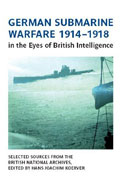
German Submarine Warfare 1914-1918 in the Eyes of British Intelligence
by Koerver, Hans Joachim2010, LIS Reinisch
ISBN 3902433795
786 pages
The book is completely based on British Admiralty WWI sources from the National Archives, Kew, UK: prisoner statements, Intelligence analysis, deciphered W/T, reports of sunken ships. It offers an incredible amount of detail about German Submarine Warfare 1914-1918: the technical design of the German submarines, their officers and men, their tactics, their cruises, their victims and their opponents.
Everything you need to know about the first submarine war and its theatres of war spreading from the US East Coast to the Mediterranean and from the Arctic to West Africa, about food and life on board, the careers of ordinary sailors, petty officers and officers, about aces like von Arnauld de la Periere with 500.000 BRT of ships sunk, about the German submarine construction program and the training of the crews.
Purchase information: (help)
 Get German Submarine Warfare 1914-1918 in the Eyes of British Intelligence now at amazon.co.uk
Get German Submarine Warfare 1914-1918 in the Eyes of British Intelligence now at amazon.co.uk 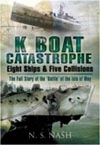
K Boat Catastrophe
by N.S. NashEIGHT SHIPS AND FIVE COLLISIONS: The full story of the 'Battle' of the Isle of May
2009, Pen and Sword
ISBN 1844159841
Hardcover, 224 pages
The "Battle of the Isle of May" was one of the strangest episodes during WWI and was suppressed for decades after the war. During the night of 31 Jan 1918 8 ships were involved in 5 collisions that resulted in 2 submarines being lost with 104 officers and men.
Purchase information: (help)
 Get K Boat Catastrophe now at amazon.com ($ 22.46)
Get K Boat Catastrophe now at amazon.com ($ 22.46) Get K Boat Catastrophe now at amazon.co.uk (£ 15.99)
Get K Boat Catastrophe now at amazon.co.uk (£ 15.99)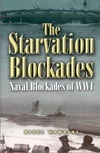
The Starvation Blockades
by Hawkins, NigelNaval Blockades of WW1
2002, Leo Cooper
ISBN 0850529085
Hardcover, 262 p., 23 illustr., in-text maps
Fairly balanced account of the British naval blockade of Germany 1914-18 and the German counter-blockade, which culminated in the unrestricted U-boat campaign in 1917. Explores political, strategic, economic, legal and military aspects. Illustrates the fateful spiral of reprisals and counter-reprisals and the effects on neutrals, especially the US.
Purchase information: (help)
 Get The Starvation Blockades now at amazon.com ($ 32.34)
Get The Starvation Blockades now at amazon.com ($ 32.34) Get The Starvation Blockades now at amazon.co.uk (£ 19.95)
Get The Starvation Blockades now at amazon.co.uk (£ 19.95)Titanic and Other Ships
by Lightoller, Charles Herbert1935, Ivor Nicholson & Watson
Hardcover, 344 pages
This book details the wildly adventurous career of Titanic officer Charles Herbert Lightoller. After surviving the Titanic disaster, Lightoller went on to command a torpedo boat in the Nore Defence Flotilla, and two destroyers of the Dover Patrol. A first-hand account, giving a vivid picture of how the "gentlemen of the other firm" felt towards the U-boats. Lightoller sank Werner Fürbringer's UB-110, and it is interesting to compare his account of their encounter with the one in Fips. The hardcover edition is a rarity, there is also a paperback edition, published by Bay Tree Press, which is more readily obtained. There is a hypertext at http://gutenberg.net.au/ebooks03/0301011h.html
Warships & Sea Battles of World War I
by Fitzsimons, Bernard (editor)1973, Phoebus, London
ISBN 0702600040
Hardcover, 160 pages, numerous photos, maps and drawings
This book presents a comprehensive account of the First World War at sea, and of the ships that fought that war.
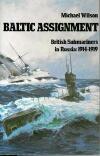
Baltic Assignment
by Wilson, MichaelBritish Submariners in Russia: 1914-1919
1985, Leo Cooper, London
ISBN 0436578018
Hardcover, 244 pages, 23 photos, 5 maps
This is the story of Max Horton, Noel Laurence and Francis Cromie, together with their gallant crews and those other submariners who fought for their country, and for Russia, in the Baltic during the period from 1914 to 1918, and then on into 1919.

Commerce War, The
by Taylor, Carl T.Unarmed Merchant Ships against German Submarines in World War I
1999, Mountain Empire Publications, Clifton Forge, VA, USA
ISBN 0966470915
Paperback, 104 pages
Thie book is fiction, but many incidents are basically true. It should be accurate historically.
WW I - Marinekorps Flandern
by Ryheul, JohanGerman Naval Air Service at the Western Front 1914-1918
2002, Regulus One Publishing
ISBN 9080745219
Stapled, 60 pages, 115 photos
7 pages of history of all 24 units and exclusive photos such as of the attack of seaplanes on the British C25 submarine.
World War One - Marinekorps Flandern
by Ryheul, JohanU-Flottille Flandern I and II
2002, Regulus One Publishing
ISBN 90807452111
Photobook, stapled, 80 pages, 149 photos
7 pages of history on the U-Flottille Flandern I and II and the harbours of Brugge, Zeebrugge and Oostende. Photos of these harbours, the submarines that operated from these harbours, the British raid on St. George's Day 1918 and action photos at sea such as ships being hit by a torpedo, sinking, crews asking for help,...
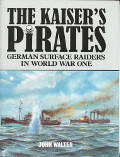
Kaiser's Pirates, The
by Walter, JohnGerman Surface Raiders in World War One
1994, United States Naval Inst.
ISBN 1557504563
Hardcover, 192 pages, numerous b&w photos and maps
Purchase information: (help)
 Get Kaiser's Pirates, The now at amazon.co.uk
Get Kaiser's Pirates, The now at amazon.co.uk 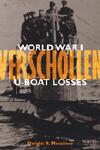
Verschollen
by Messimer, Dwight R.World War I U-Boat Losses
2002, United States Naval Inst.
ISBN 155750475X
Hardcover, 341 pages, numerous b&w photos and maps
Until now, finding reliable information on U-boats lost during World War I required fluency in German and a great deal of time. Not only was little information available in English but also German sources were difficult to track down and provided the barest of facts. Long in the making, this new reference fills the needs both of researchers looking for details of lost submarines and readers who enjoy action and adventure. It provides a comprehensive examination of each of the 203 U-boats that the Germans lost in the war. Fluent in German and at home in war archives, Dwight Messimer offers for the first time individual narratives of the men who survived their boat's sinking. Several made difficult escapes from sunken wrecks, and one man bailed out just as his submarine plunged past the 100-foot mark. Others were on deck or atop the coning tower when their boat went under. In the case of boats listed as verschollen, or lost without a trace, the author includes explanations given for what might have happened or in the case of conflicting evidence, analyzes the explanations for accuracy. Each boat entry is a narrative that stands alone allowing readers to easily focus on a particular submarine. Researchers will appreciate the convenience of the book's format and the all-inclusive nature of the information listed. Because Messimer provides the approximate locations of many of the wrecks, amateur and professional salvage divers wanting to visit wreckage sights also will find the book useful.
Purchase information: (help)
 Get Verschollen now at amazon.co.uk
Get Verschollen now at amazon.co.uk 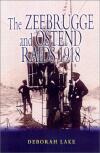
Zeebrugge and Ostend Raids 1918, The
by Lake, Deborah2002, Leo Cooper/ Pen and Sword Books
ISBN 0850528704
Hardcover, 208 pages, 2 maps, 33 photos
This book covers the naval war between the units of the German Marinekorps Flandern and the British Navy in 1917-1918 in the North Sea and Channel, and especially the danger of the German U-boats operating from the Belgian ports. It looks at the story from both sides, which makes it rather unique; shows the importance of politics in the British Navy (especially to get the Dover command); and most of all shows that the raids on St. George's Day 1918, made in an attempt to block the harbours of Zeebrugge and Oostende, were not the success they are always made out to be in British history books. Coverage is very complete. The part providing the German point of view was reviewed in its entirety by Johan Ryheul, author of Marinekorps Flandern.
Purchase information: (help)
 Get Zeebrugge and Ostend Raids 1918, The now at amazon.co.uk
Get Zeebrugge and Ostend Raids 1918, The now at amazon.co.uk 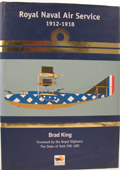
Royal Naval Air Service 1912-1918
by King, Bradley1997, Hikoki Publications, Aldershot
ISBN 0951989952
Hardcover, 160 pages, photos
The story of the Royal Naval Air Service previous to World War I and during the war, from Oostende to the Dardanelles, Africa, the Mediterranean, to Gallipoli, Romania and Russia. Also covers the war versus Zeppelins and the war versus German ships and U-boats. Almost a pictorial as there are an enormous amount of never-before-published photos in it.
Purchase information: (help)
 Get Royal Naval Air Service 1912-1918 now at amazon.com
Get Royal Naval Air Service 1912-1918 now at amazon.com  Get Royal Naval Air Service 1912-1918 now at amazon.co.uk
Get Royal Naval Air Service 1912-1918 now at amazon.co.uk Naval Memoirs 1916-1918
by Keyes, Sir RogerScapa Flow to the Dover Straits
1935, Thornton Butterworth, London
Hardcover, 416 pages, 16 maps and drawings, 13 photos
This is a portion of the naval memoirs of this admiral, almost a song of praise for himself. However it also gives a very good overview of the anti-submarine activities in the Channel for which he was responsible as he held command of the Dover Patrol. Of course the Zeebrugge and Oostende raids by his men in 1918 on St.-George's Day were enormous successes and both harbours were completely blocked if you want to believe the man. The reality was somewhat different.
Glory of Zeebrugge, The
by Keble, Howard1918, Chatto and Windus - London
64 pages, 16 photos, 1 map
The official narratives on the Zeebrugge and Oostende raids by the British on St. George's Day, 1918 in an attempt to block both these German-occupied harbours. The book was pure propaganda and is even still today on a secret list of propaganda books at the Imperial War Museum in London.
By Guess and By God
by Carr, William GuyThe Story of the British Submarines in the War
1930, Hutchinson & Co., London
Hardcover, 288 pages, 9 photos
A real bestseller from this period of time which covers almost the complete submarine war from the British side in World War I. It reads like a novel but is not always completely accurate. Preface written by Admiral S.S. Hall who commanded the British Submarine Service for the greater part of the war.


